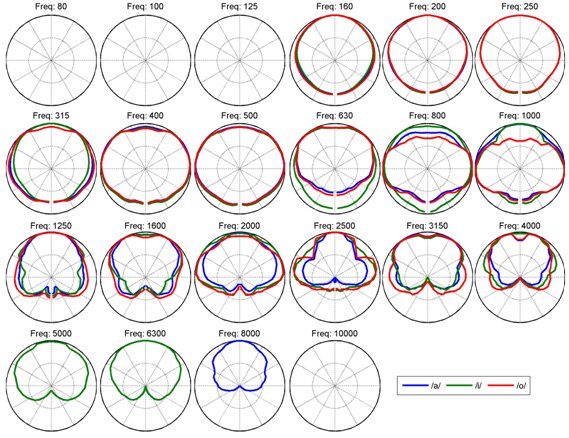You are using an out of date browser. It may not display this or other websites correctly.
You should upgrade or use an alternative browser.
You should upgrade or use an alternative browser.
The best 'speakers are the width of a human head - discuss
- Thread starter Robert
- Start date
tuga
Legal Alien
Having listen to box speakers all my life, personally I prefer listening to a good omni. When done right it doesn't sound like you are listening to your room and if you haven't heard it you won't understand. Some think that Omni's means vague and reverby sound and imaging but it's absolutely not the case.
From the Fremer review...
Like I said, it's a matter of preference.
I'm allergic to Fremer, I can't understand how anyone can read him...
Duevel speakers from the Venus model upwards have their drivers' centres aligned on a one-dimensional vertical line. I'm guessing from the resulting sound that this is a decidedly good thing. It's certainly unusual.
They also have deliberately simple, "phase linear" (their words, not mine) crossovers. This doesn't seem to do any harm either.
http://www.duevel.com/Produkte/Evenus.shtml
They also have deliberately simple, "phase linear" (their words, not mine) crossovers. This doesn't seem to do any harm either.
http://www.duevel.com/Produkte/Evenus.shtml
camverton
pfm Member
The problem with discussing omnis of the MBL type is that few people have heard them outside of a crowded hotel room at a show. This leads people to theorise about how they think they will sound, some even refer to the manual of a speaker which has an omni effect to make their erroneous points. When well set up, and not everyone will have enough space, they give superb imaging and a realistic, holographic, sense of the performers playing in front of one like no other speaker type I’ve tried. They are not ideal, perhaps, for those who want to replicate what the engineer heard. They are best, however, for anyone who regards high fidelity as a realistic recreation of the original performance. All a question of taste of course.Having listen to box speakers all my life, personally I prefer listening to a good omni. When done right it doesn't sound like you are listening to your room and if you haven't heard it you won't understand. Some think that Omni's means vague and reverby sound and imaging but it's absolutely not the case.
From the Fremer review...
"No box above the bottom octaves and a 360° radiating pattern should produce imaging and soundstaging superior to that of any boxed or planar speaker, and once the speakers had been placed properly, the 101E Mk.IIs did just that, reproducing with eerie verisimilitude recordings of large orchestras as well as of small ensembles in intimate settings, such as a superb-sounding reissue of Johnny Hartman's I Just Dropped By to Say Hello (LP, Impulse!/ORG 176). The sound was intimate and properly sized, and produced Hartman's baritone with a natural warmth free of congestion or bloat.
Going back to some of the live Carnegie Hall tracks I listened to for my 2004 review reinforced the 101E Mk.IIs' astonishing spatial abilities. The speakers' presentation of physical instruments and musicians in space required no suspension of disbelief—the holographically three-dimensional picture was just there. The Weavers' Reunion at Carnegie Hall 1963 (single-sided 45rpm LPs, Vanguard/Classic 2150) was reproduced with the singers arrayed holographically across the stage. The images of Ronnie Gilbert's and Pete Seeger's voices and the glistening acoustic guitars were as convincingly portrayed as I've heard them here, including the toe-tapping, the wooden stage floor, and the airy, open space. Lights out and you're there!"
For the theorists who talk of secondary reflections, I think they need to consider the time delay, and reduction in volume between them and the direct sound. Then there’s the tricky bit; assessing how the brain differentiates between direct and secondary sound and how it recreates the information to reconstruct the music in our minds.
There are compromises to be made in that they need to be situated away from walls and also that they are bloomin’ expensive, Worth it though for my ears!
Now contrast this with a wide directivity speaker, you are now basically bouncing treble off the side walls, floor, ceiling etc and the delay between direct and reflected sound becomes far shorter, more blurred, and harder to pick apart.
Yet this is precisely how most musical instruments work. Virtually no instrument produces sound in a very narrow beam like some loudspeaker treble units do, they throw sound in all directions.
It depends on what you want. Very directional speakers can paint you a picture of instruments in the distance but if you want the illusion of solid instruments in your room then wide dispersal mimics the sound of real instruments better.
Over the years I've been in concert halls where they've built the room to try a manage reflections precisely to give a perfect sound and in other buildings with odd shaped walls. They almost always just sound weird or not very good.
Tony L
Administrator
It depends on what you want.
Absolutely. This is the key. I’ve come to the conclusion I want the studio control-room sound as it is the only ‘real’ on offer. I want to hear the decisions the engineers made through as close to the equipment they used to make them as I can get in my house. It is no accident that I own proper studio monitors and nearfields. The absolute last thing I personally want to do is to use the room as an FX generator to add reverb or whatever to fake the sound of a rock band PA in a pub or something like that. I just want the sound of Abbey Rd’s Tannoys, Rudy Van Gelder’s Altecs or whatever. That isn’t to say I don’t like or respect other speakers and presentations, but mostly they are all fairly close to this monitor pedigree (Quads, Altecs, BBC monitors, MEGs etc). I guess I’ve had a fairly big ‘taste shift’ over the past decade or two and moved away from the ‘flat earth’ thing as just being too odd/impractical in many ways to play the range of music I now want to play. I keep coming back to fairly narrow dispersion close to point-source monitor speakers in a fairly dead room.
gingermrkettle
Deep vein trombonist
Except instruments have very different patterns, compare a piccolo trumpet and french horn for example, which will be picked up by more than just one mike channel when recorded.
Except instruments have very different patterns...
They do, but nothing beams sound like a very directional Hi-Fi loudspeaker does. Even relatively directional instruments like the ones you mention can be heard perfectly well from the side. This isn't true of some loudspeakers.
tuga
Legal Alien
The problem with discussing omnis of the MBL type is that few people have heard them outside of a crowded hotel room at a show. This leads people to theorise about how they think they will sound, some even refer to the manual of a speaker which has an omni effect to make their erroneous points. When well set up, and not everyone will have enough space, they give superb imaging and a realistic, holographic, sense of the performers playing in front of one like no other speaker type I’ve tried. They are not ideal, perhaps, for those who want to replicate what the engineer heard. They are best, however, for anyone who regards high fidelity as a realistic recreation of the original performance. All a question of taste of course.
For the theorists who talk of secondary reflections, I think they need to consider the time delay, and reduction in volume between them and the direct sound. Then there’s the tricky bit; assessing how the brain differentiates between direct and secondary sound and how it recreates the information to reconstruct the music in our minds.
There are compromises to be made in that they need to be situated away from walls and also that they are bloomin’ expensive, Worth it though for my ears!
MBL's Jürgen Reis is a theorist. He uses "secondary reflections" knowledge or theory to what in his view and yours is a good effect.
But there is more than just theory involved. Someone who prefers a deader room and narrow directivity speakers such as horns or dipoles can make an educated guess about what to expect from a speaker which disperses sound in every direction.
I agree that the price is off-puting even for those who tendentially prefer wide or omni, let alone those who do not.
I also agree about all being a question of preference.
I definitely disagree that omnis "are best, however, for anyone who regards high fidelity as a realistic recreation of the original performance". This is still your opinion and taste against theory.
Some people like the listening room to actively reverberate the recorded sound (yourself) whilst others like a more silent listening room that lets the original acoustic cues come through with as little interference as possible. Preference.
tuga
Legal Alien
They do, but nothing beams sound like a very directional Hi-Fi loudspeaker does. Even relatively directional instruments like the ones you mention can be heard perfectly well from the side. This isn't true of some loudspeakers.
Have you ever listened to a flute, an obeo or a trumpet played live?
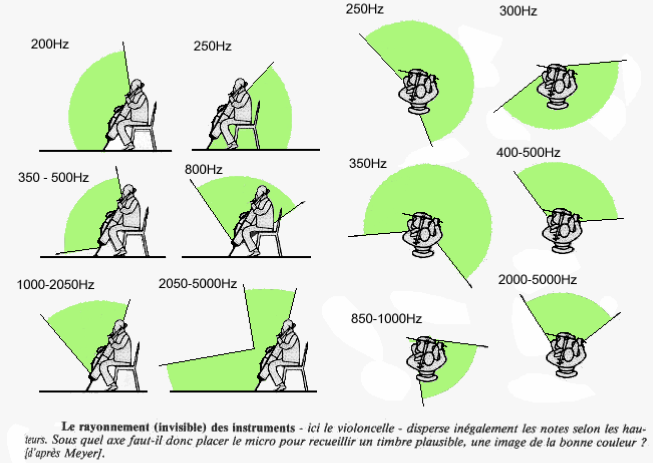
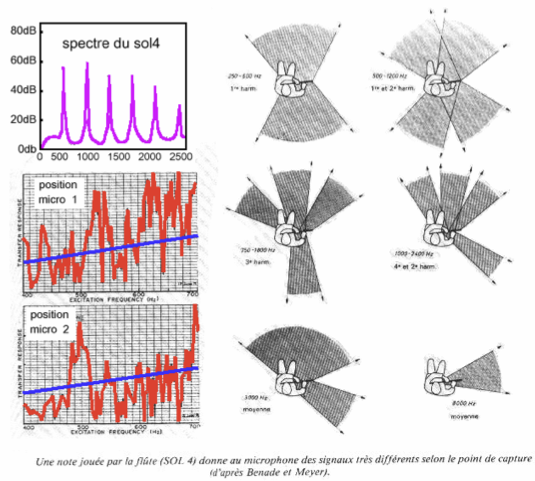
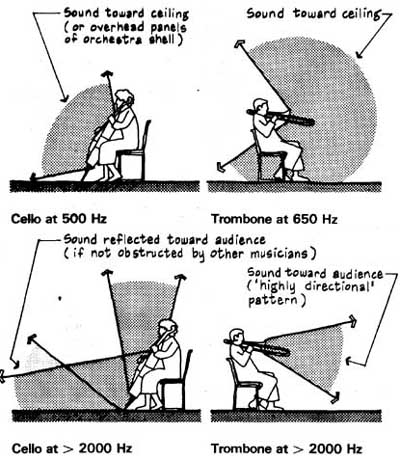
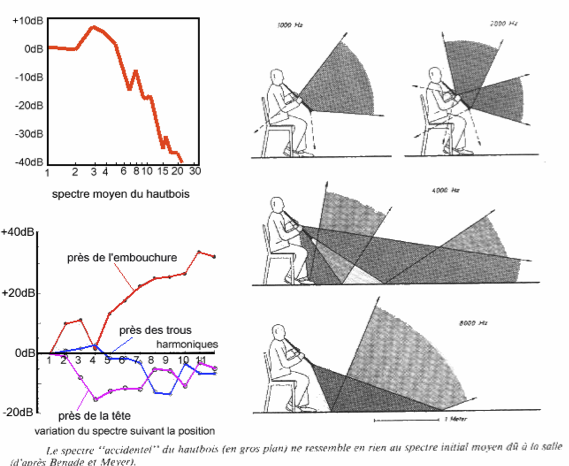
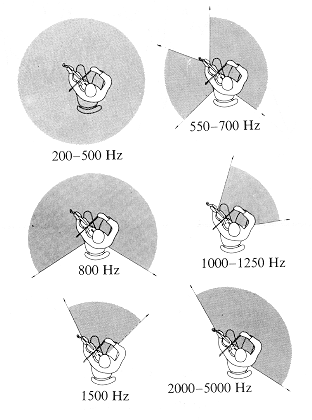
tuga
Legal Alien
It depends on what you want. Very directional speakers can paint you a picture of instruments in the distance but if you want the illusion of solid instruments in your room then wide dispersal mimics the sound of real instruments better.
The goal of stereo recording is not to reproduce single instruments but a snapshot or soundscape of a musical event which includes the sound of the instruments and the sound of the venue as listened from a good seat in the audience (I am referring to classical music and this is of course dependent on the mic'ing technique used).
Very directional speakers will beam that snapshot at the listening spot, omnis will throw the snapshot against the side walls and create a miriad of reflections, like a house of mirrors. It is overlaying the listening room acoustics over the recorded ambience cues.

gingermrkettle
Deep vein trombonist
650Hz is quite high for a trombone...
tuga
Legal Alien
650Hz is quite high for a trombone...
Overtones?
*
Quite often. Orchestras, jazz bands, quartets and other small combos, many times in many circumstances. Church groups, on the street, in people's houses....
Have you ever listened to a flute, an obeo or a trumpet played live?
Quite often. Orchestras, jazz bands, quartets and other small combos, many times in many circumstances. Church groups, on the street, in people's houses....
James
Lord of the Erg\o/s
All this talk about direct vs reflected sound and yet, no love for the Bose 901? 
Directivity, acoustic centre alignment, relative phase and filter topologies (just to name a few of the design parameters) all play a part in how loudspeakers sound in any given context, that I'm sure you all know.
A head-sized baffle alone won't necessarily make human voice sound more coherent, if the loudspeakers are carelessly positioned or if the crossover topology yields gross relative phase errors. Given that most of us strive for audio nirvana in our homes, I will only add that the room matters most, followed closely by the loudspeaker pair.
For conventional front-firing, boxed loudspeakers, my three house rules are:
(1) distance between loudspeakers should be roughly the same as distance of each from their side walls;
(2) room nodes and modes are unavoidable, but can be tuned out by careful positioning. LF should pressurise the room evenly. If it sounds boomy in corners and hollow in the middle, it's not right;
(3) toe matters, adjust until focus is established. You'll know it when you hear it, from your listening position.
Directivity, acoustic centre alignment, relative phase and filter topologies (just to name a few of the design parameters) all play a part in how loudspeakers sound in any given context, that I'm sure you all know.
A head-sized baffle alone won't necessarily make human voice sound more coherent, if the loudspeakers are carelessly positioned or if the crossover topology yields gross relative phase errors. Given that most of us strive for audio nirvana in our homes, I will only add that the room matters most, followed closely by the loudspeaker pair.
For conventional front-firing, boxed loudspeakers, my three house rules are:
(1) distance between loudspeakers should be roughly the same as distance of each from their side walls;
(2) room nodes and modes are unavoidable, but can be tuned out by careful positioning. LF should pressurise the room evenly. If it sounds boomy in corners and hollow in the middle, it's not right;
(3) toe matters, adjust until focus is established. You'll know it when you hear it, from your listening position.
tuga
Legal Alien
*
Quite often. Orchestras, jazz bands, quartets and other small combos, many times in many circumstances. Church groups, on the street, in people's houses....
A jazz band is a good example: when the brass are all playing to one side and then turn and play to the other, the very narrow directivity is quite obvious. Or an army marching brass band walking past.
tuga
Legal Alien
All this talk about direct vs reflected sound and yet, no love for the Bose 901?
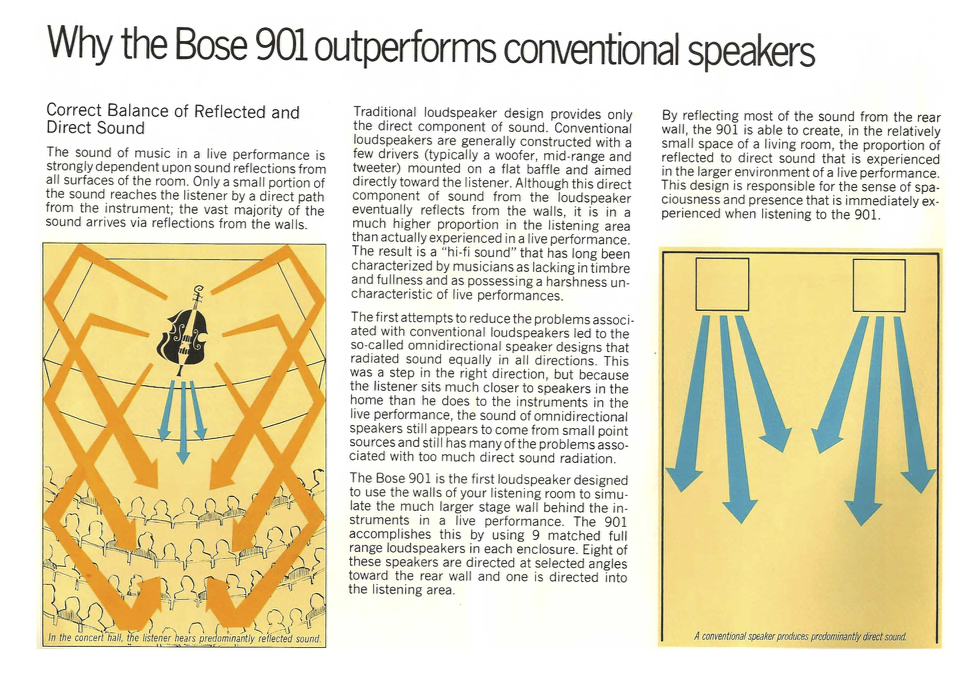
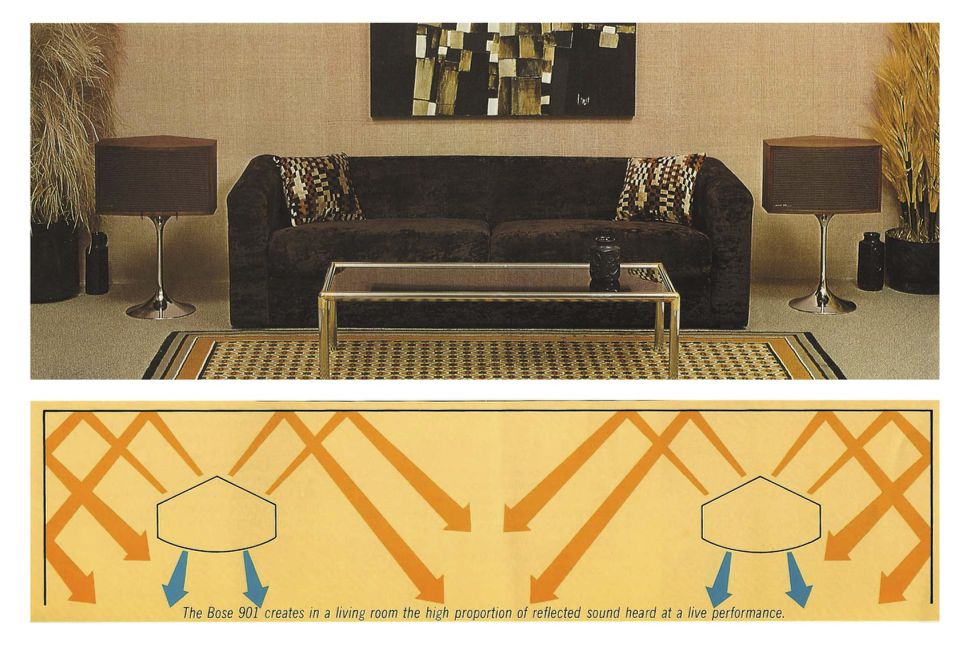
This might work for recordings which are studio constructs; for recordings which are intended to be reproductions of the sound heard in a concert hall, I am not convinced....I want the studio control-room sound as it is the only ‘real’ on offer. I want to hear the decisions the engineers made...
My standard is (well was, until March...) to go to a concert which is being broadcast on Radio 3, then to re-live the experience via BBC Sounds through my system the following evening. The broadcast, as played at home through omni speakers, often portrays the sound heard live remarkably convincingly. The main difference is usually that the BBC engineers create a sound picture that is even more persuasive than the one heard from my specific seat. I have tried this experiment repeatedly, booking seats in different parts of the halls I visit regularly, and learned something in the process - mainly that as long as I am in my current listening room I need not bother to think about changing my speakers. As fas as that part of my system is concerned, and for the kind of music I favour, I have arrived at the ideal.


